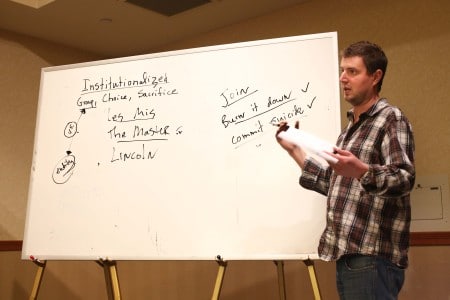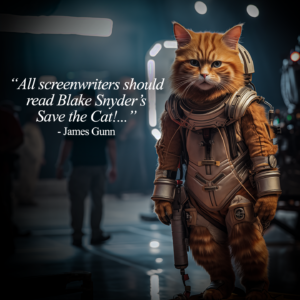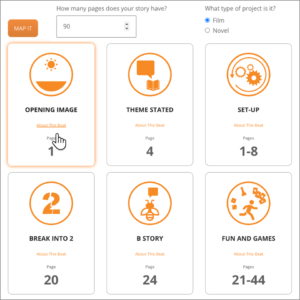
After teaching a recent Beat Sheet Workshop in New York City, Master Cat! Ben Frahm and some great writers experienced a couple of breakthrough moments that really crystallized the benefit of outlining your story. Ben reports:
Using the 15 beats of Save the Cat!, students were able to identify problem areas and structural advantages before they dove in and started writing. And in figuring out some of the major turning points, it became clear that there was a tendency to overthink. To overcomplicate these beats. There’s an inclination to get caught up in the minutia of the scene or what the character is wearing or what they did earlier that day, or had for breakfast two days ago, and all the while, miss the important information of that scene… the actual beat.
Here’s an example. We looked at the movie The King’s Speech as a template for great structure, particularly on how it relates to the 15 STC! beats. And students were surprised to see that some of these major turning points and story beats were actually quite simple. For instance, Opening Image could be simplified as “KING STUTTERS.” And the Closing Image and scene could easily be put on a 3 X 5 card as “KING NO LONGER STUTTERS.”
However, it was easy to get caught up in some of the other details of those beats. The date that the movie took place. The wardrobe of the King. The peripheral characters present. What time of day was it? What country were we in? Was there a war going on at the time? Is the King really a soccer fan in the beginning? But all the while, we neglect the important information… the essence of the beat.
And in doing so, students were able to realize that it’s important to boil down your beats. To clean out all of the extra information and focus on the bare bones of what is actually happening. What’s moving the story ahead? And what is the most important information that can be captured in only a few sentences on a 3 X 5 card (or your nifty virtual card in the STC! software).
And to our surprise, once this was digested, the outlines of the students’ stories immediately improved. They became clearer. More focused. And there was a lot less superfluous information. The writers started focusing on the necessity of the beats and how they served their overall stories.
So… in looking ahead… keep it simple. Find those simple 15 beats that your story’s structure rests on… and keep all of the detail and minutia and extra information… for the actual writing of the script.
Don’t let those details get you stuck in the beginning. Move ahead. And look at the big pieces. Because that’s what makes for good, clear beats. And ultimately what allows for a well-structured, impactful story.
Keep the beats SIMPLE!
Ben Frahm
13 Comments
Leave a Reply Cancel reply
You must be logged in to post a comment.









This could possibly have been the most helpful posting of the year.
And ironically, it’s the simplest!
Thanks.
David
As one of the students in that workshop I can testify to the importance of “King Stutters”. It has become my mantra. In my mind, going forward, keeping the beats as simple as possible is key to getting to the 15th Beat. And getting to the 15th Beat frees me to start writing, where I can use all those details and specificity to tell the story. It was a break through moment for me and thanks Ben for creating the space to let it happen.
I was in that workshop – it’s totally true. A lot of us were bogged down in the details (myself included). Thanks to Ben for helping us clear away the unnecessary and get to what’s important. :)
Ben has articulated the true meaning of K.I.S.S. (Keep it Simple Stupid), as it applies to the “Beats”.
Thanks for the reminder!
Bob
Great advice! My biggest issue is think I need to know the whole scene in great detail before I move to the next beat.
I also participated in that NYC workshop which I found most helpful. By early afternoon on the second day, I felt I had nailed down the 15 beats thanks to Ben and to comments from fellow participants. I must confess I found the first day a bit frustrating– getting rid of old habits is not easy.My next challenge now is on fleshing out the scenes that arise from the beats: again the question of level of detail arises, as well as do we focus on the plot or the characters? Any advice from fellow Cats?
Thanks,
I could not make the workshop, so thanks for giving me what makes a differnce. I love the “Beats” and had written some pretty good stuff using them, so I decided, “If 15 beats is good, I’ll go to a beat per page.” I got too complicated and hurt a good tale. I’m rewriting “MO”, and my first beats are
1. Wonderful Doctor believes in science and does not believe in God.
2. Wonderful Doctor Meets God and science is explained.
3. Wonderful Doctor believes in God and uses science for entertainment.
I’ll restart with Beginning,Middle,End, and put in the other twelve beats.
Vinod B,
I can answer your question since I always get good review on Character.
You can’t describe your characters in a script like an author. What your audience thinks of your character is developed by what is seen and said as he or she skips down the yellow brick road of your plot.
Ben has articulated the true meaning of K.I.S.S. (Keep it Simple Stupid), as it applies to the “Beats”.
Wonderful post! The KISS approach is definitely helpful and makes you work faster. I used to get lost in details, but now I work in very small sentences, one line long at most, and I make sure there is progression from line to line. Thus I ensure it is simple enough to keep working.
Ben, excellent! “Focus on the necessity of the beat and not the minutia.”
BRADFORD; GREAT! I MEAN IT. Babzbuzz and our agency Silver Bitela Agency has a protocol and it works; if WE like OR Love your pitch, we ask for professional coverage AND the Blake Snyder beat sheet. We won’t read anything anymore without it. FOLKS need to understand foreshadow and payoff and if the beats are RIGHT this is practically handed to them. Subtext too, sadly not done enough (I give you Linda Seger’s book Writing Subtext, a MUST), goes hand in hand with the beats. It may SOUND at first blush that is is anything but simple. You’re right. Writing is hard. BUT THE BEATS allow those seeds to be dropped and what I am looking for as agent is that the beats are there. They must be from jump. THANK YOU BRADFORD.
Thank you Ben! This is indeed brilliant! I just applied it to my WIP and it totally helped me see the forest and ignore those pesky trees! I’d love to attend one of your workshops one day. If you ever do one in London, let me know!